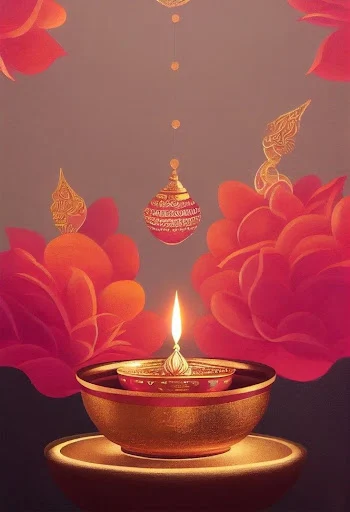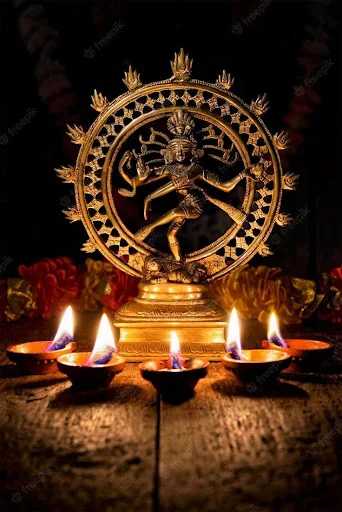New Year in Hinduism
A Profound Celebration of Renewal and Abundance
In the vibrant tapestry of Indian culture, the Gujarati New Year, also known as "Bestu Varas" or "Nutan Varsh," shines as a significant and spiritually enriching festival celebrated primarily in the state of Gujarat and among the Gujarati diaspora around the world. This auspicious occasion marks the commencement of the Hindu calendar and is characterized by its deep-rooted customs, rich traditions, and profound symbolism. In this extensive article, we will embark on a detailed exploration of the Gujarati New Year in Hinduism, unveiling its intricate customs and the deep significance it holds within the hearts of its celebrants.
The Gujarati New Year traditionally takes flight just after the grandeur of Diwali, the Festival of Lights. This transition typically falls within the months of October or November, in harmony with the lunar calendar. The timing of this celebration is not merely a matter of coincidence but carries immense cultural and spiritual weight. It signifies the dawn of a new agricultural and financial cycle, symbolizing the resetting of life's many clocks.
At the heart of the Gujarati New Year lies a profound significance that resonates deeply within Hindu culture. It represents a fresh beginning, a moment to shed the baggage of negativity, and a heartfelt welcome to prosperity. Devotees believe that on this auspicious day, the benevolent Goddess of Wealth, Lakshmi, blesses their homes, ushering in an era of good fortune and abundance. The Gujarati New Year is not merely a date on the calendar; it is a powerful symbol of renewal and hope.
Rituals and Traditions
Annakut
The Annakut, translating to "a mountain of food," stands as the focal point of Gujarati New Year celebrations. This elaborate and heartwarming tradition involves devotees meticulously preparing an extravagant feast that includes a diverse array of vegetarian dishes, delectable sweets, and a profusion of offerings to the deities. The painstakingly assembled spread is then offered with deep reverence in temples or homes, a heartfelt gesture to seek divine blessings for the year that lies ahead.
Lighting Diyas
As the sun sets and darkness engulfs the world, oil lamps or diyas are kindled in every home. This act is not just a routine; it is a profound symbol of the eternal triumph of light over darkness, knowledge over ignorance, and good over evil. The warm, flickering light is a beacon of hope, guiding people towards a brighter future.
Prayer and Aarti
Devotees embark on pilgrimages to temples with unwavering devotion, where they offer their prayers and partake in the mesmerizing aarti. This beautiful and spiritually enriching ritual involves the rhythmic waving of lit lamps in front of the deities, accompanied by soulful devotional hymns. It is a moment when the physical and the divine converge, creating an atmosphere of deep spirituality.
Charak Puja
In certain regions of Gujarat, a daring and unconventional ritual known as Charak Puja takes center stage. This unique and thought-provoking act entails tying a brave devotee to a revolving wooden wheel, suspending them in the air. It is believed that by undergoing this ordeal, an individual's sins are cleansed, symbolizing a fresh start and a reconnection with one's spiritual journey.
Business Accounts
Within the business and trading community, the Gujarati New Year holds a unique and practical significance known as "Chopda Pujan." On this auspicious occasion, businessmen and traders ceremoniously close their existing account books, symbolizing the conclusion of the previous financial year, and embark on the opening of new ones. This ritual marks the inception of a fruitful and prosperous financial year, emphasizing the inseparable connection between spirituality and economic prosperity.
The Gujarati New Year transcends the boundaries of religion and spirituality, embracing a broader sense of community and togetherness. Families unite, friendships are rekindled, and the rich tapestry of Gujarati culture shines through.
Gift exchanges, the sharing of delectable sweets, and the exchange of heartfelt wishes are common practices during this time. Vibrant and traditional folk dances, such as the Garba and Dandiya, fill the air with joy and rhythm, enhancing the overall festive atmosphere. The community comes alive with laughter, music, and a palpable sense of unity.
New Year in Hinduism is far more than just a festival; it is a profound celebration of spirituality, tradition, and unity. It beckons individuals to reflect upon their lives, rejuvenate their spiritual connections, and celebrate their Indian heritage with fervor and enthusiasm. The customs and traditions associated with this occasion serve as a bridge to the past and a gateway to the future, uniting people in their pursuit of renewed hope, prosperity, and blessings in the year ahead. The Gujarati New Year is a reminder of the enduring connection between tradition and renewal, culture and spirituality, and the unity of a diverse and vibrant community.
















